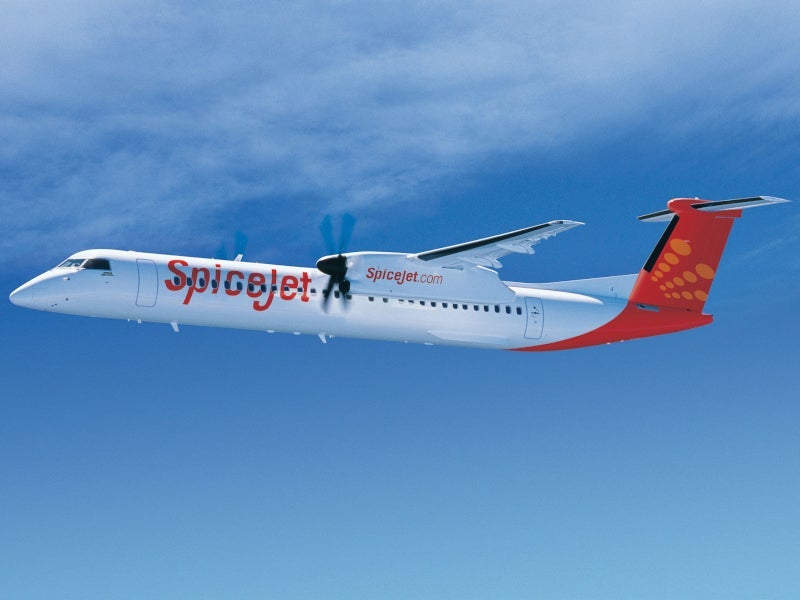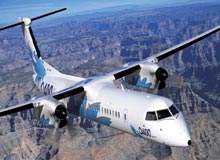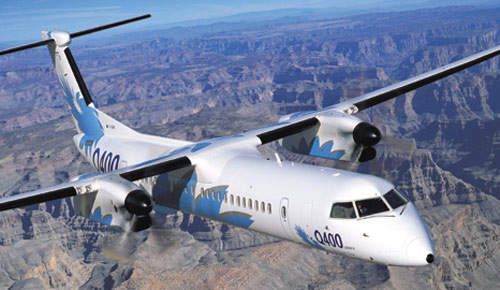Bombardier Aerospace’s Dash 8 family of turboprop regional airliners includes the 37-passenger Q100 and Q200, the 50 to 60-passenger Q300 and the 70 to 80-passenger stretched Q400. The newest member of the Dash 8 family, the Q400, had its first flight in 1998 and entered commercial service in February 2000.
The Q400 Dash 8 airliner was developed by Bombardier to meet the requirements of regional airlines for larger aircraft on high-density, short-haul routes. The 350k Q400 airliner is one of the world’s quietest turboprop aircraft. The noise and vibration suppression system (NVS) was introduced on the Dash 8 turboprop family in 1996.
The aircraft’s speed and 2,519km range provide airlines with the capability to service markets beyond conventional turboprop aircraft distances. The Q400 programme was launched in 1995 as a stretched version of the Q300 series.
Transport Canada granted certification for the new variant of Q400 featuring a 90-seat layout in August 2018.
De Havilland Aircraft of Canada took over the Q Series aircraft programme from Bombardier in June 2019.
A total of 600 Q400 aircraft were delivered as of September 2019.
Dash 8 Q400 orders and deliveries
Major operators include SAS Commuter (launch customer), Augsburg Airways of Germany, Horizon Air of USA, Tyrolean Airways of Austria, Qantas Airways, Horizon Air, Flybe, Colgan Air / Pinnacle, Porter Airways and All Nippon Airways of Japan.
In October 2001, the Q400 airliner was approved by Europe’s Joint Airworthiness Authorities for steep-approach operations, in preparation for approval to operate at London City Airport (LCY), which has a runway approach angle of 5.5°.
A test aircraft of the Q400 became the first Canadian aircraft to fly on D7566 biofuel. D7566 is certified by the American Society for Testing and Materials (ASTM). Porter Airlines is planning to carry out Canada’s first biofuel-powered revenue flight on its Q400 aircraft.
In November 2019, Palma signed a letter of intent with De Havilland Canada to purchase 20 Dash 8-400 aircraft. In the same month, Elin Group placed a firm order for three Q400s and the Republic of Ghana signed a letter of intent to acquire up to six Q400s.
Ethiopian Airlines took delivery of 25th Q400 aircraft in July 2019.
TAAG Angola Airlines placed order for six Q400 aircraft in June 2019 and took delivery of the first aircraft in June 2020.
In September 2017, Indian airline SpiceJet placed an order worth $1.7bn for 25 Q400 turboprop airliners with purchase rights for additional 25 aircraft.
Qazaq Air JSC of Kazakhstan leased three Q400 aircraft from Falcon Aviation Services of Abu Dhabi in 2015. The airline placed order with Bombardier for two Q400s in 2017 and took delivery of the first aircraft in April 2019.
Dash 8 Q400 NextGen variant
The Q400 NextGen, an improved version of the Q400, was announced in March 2008. The new aircraft has improvements to the cabin environment, including LED lighting, new ceiling panels, dished window sidewalls and larger overhead bins.
Q400 NextGen participated in the 2012 FIDAE Air Show held in Santiago, Chile, in March / April 2012. Recent orders for the Q400 NextGen include 20 aircraft from Eurolot in March 2012, five aircraft for Ethiopian Airlines, two for Horizon Air in February 2012, two dual-class Q400 NextGen for RwandAir in February 2014, and ten aircraft for Air Kazakhstan in July 2014.
Q400 flight deck and systems
The dual control cockpit manufactured by De Havilland Canada accommodates the pilot and co-pilot. The electronic flight instrumentation system (EFIS) has five high-resolution, 6in x 8in liquid crystal displays. The flight deck can be fitted with a holographic guidance system from Flight Dynamics.
The aircraft’s avionics system was developed by Thales Avionics (formerly Sextant Avionique). The communications suite includes a dual VHF navigation and communications and mode S transponder.
The cockpit is also equipped with an emergency locator transponder and a solid-state cockpit voice recorder.
Navigation equipment includes a weather radar, a ground proximity warning receiver, a radar altimeter, an automatic direction finder and distance measuring equipment. The aircraft has provision for a flight management system, a global positioning system and a traffic alert and collision avoidance system, TCAS II.
Dash 8 Q400 cabin
The cabin can be configured for single-class or two-class layout for 68 to 78 passengers. SAS Commuter operates the aircraft with 58 seats in an all business-class configuration.
Air-stairs installed at the front of the cabin allow the aircraft to use airports with limited ground support facilities. Two passenger doors and one service door allow the aircraft to embark and disembark passengers quickly. The aircraft has more than 14m³ of baggage hold.
Fuselage
The near-circular in cross-section fuselage and the tail sections are manufactured by Mitsubishi. The fuselage and tail sections are transported to the De Havilland Canada manufacturing facilities in Ontario where the cockpit and wings are constructed for final assembly of the aircraft and system fits.
The Allied Signal electrical power system includes two starters / generators for DC power, two transformer units and two nickel-cadmium batteries. There are two engine-driven AC generators to supply variable frequency AC power.
The wings, tailplane and fin leading edges are fitted with de-icing systems.
Q400 engine and performance
The aircraft is powered by two turboprop engines type PW150A supplied by Pratt & Whitney Canada. Each engine develops 5,071hp or 3,800kW. The turboprop engines, mounted in Shorts engine nacelles, have full authority digital engine control (FADEC).
The engines drive six-bladed reversible-pitch composite propellers, type R408, supplied by Dowty. The propeller blades are fitted with an electrical de-icing system.
The total fuel capacity is 6,526l giving a maximum range of 2,519km carrying 74 passengers. The maximum cruise speed is just under 650km/h (403mph).
Landing gear
The aircraft has Menasco retractable tricycle-type landing gear. Each unit has twin wheels fitted with Goodrich anti-skid brakes. The two independent hydraulic systems are supplied by Parker Bertea Aerospace.





